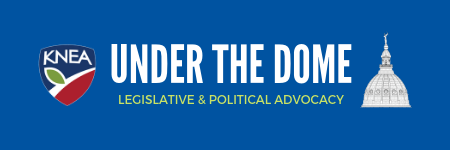Alvarez and Marsal, the firm hired to review Kansas for potential efficiency savings, released their 257-page report today before the House Appropriations Committee and the Senate Ways and Means Committee.
The report has numerous chapters including one devoted entirely to the Department of Education.
Within the chapter on KSDE, they had six recommendations.
Recommendation 1: Reduce Excess Cash Carryover Balances
This has been a topic of discussion for years under the dome. A&M recommends setting a 10% minimum for carryover and a 15% maximum. Districts with excess cash balances would have that excess recovered by the state through an “adjustment” in funding by 20% of the excess. This recommendation would essentially force school districts with large balances to spend them down quickly or risk reductions in aid. We would consider this an alarming precedent to take.
Recommendation 2: Apply for Additional Funds from Public and Private Sources
In this recommendation, A&M suggests more grant writing in an attempt to find and take advantage of other sources of funding. Most school districts already try to maximize grants. The A&M report suggests more support for school districts in this effort.
Recommendation 3: Pursue Cost Savings Opportunities through Centralization and Shared Services Agreements
This recommendation focuses on centralizing IT functions, creating a centralized IT Division.
Recommendation 4: K-12 Benefit Program Consolidation
Most people agree that larger experience pools that spread risk generally results in lower overall premiums. A&M uses this as a bottom-line assumption.
A&M makes savings estimates in the report which they admit may or may not be correct. The answer would lie in the details of any consolidated plan and would be based on many as yet undefined parameters.
It is clear that A&M put a lot of thought into this section of the report and they make it clear in the report that much work still needs to be done before any state-wide educators’ health benefit plan could be implemented. The critical steps to implement on pages 175 and 176 are essential to be completed prior to a final decision to move forward on such a plan. We applaud A&M for listing these critical elements and especially their recommendation to include key stakeholder groups including KNEA.
Much work and analysis is yet to be done and we look forward to working with the legislature and other stakeholders in getting that work done.
We would be remiss not to raise two issues that give us pause.
First there is the issue of how the pool would be funded. Would districts pay the state, would the state pay the cost as they have done the employer contribution to KPERS? How can we be certain that the same funding issues in KPERS would not be repeated with such a state-wide health insurance pool?
Secondly, we are concerned with the recommendation on the SEHP that only high-deductible plans be made available. Kansas is experiencing a teacher shortage as well as difficulty in recruiting state employees. High-deductible plans would be a deterrent to employment in public service and exacerbate such difficulties.
Recommendation 5: Collaboratively Source Select Categories on a State-wide Basis
This is another much-discussed idea under the dome. They suggest that savings can be found by districts cooperating more extensively in the procurement of IT services, food, software, and a variety of other items. Many school districts have already moved in this direction.
Recommendation 6: Expand Participation of the K-12 Unified School Districts in Insurance Pool Programs
This recommendation gets to insurance programs other than health benefits and encourages more pooling of risk to reduce premiums. They also recommend that the 10 largest school districts be one pool together.
What happens next?
Nothing has been decided. This is just a report making suggestions and recommendations. Every recommendation has a series of “critical steps to implement” that need to be considered. There will be many decision points along the way in crafting a legislative response to each recommendation. The budget committees of the House and Senate will be using this report as they work through the legislative session.
One should not look upon this report as the solution to the state’s budget woes. Our problems were brought on by decisions to radically and recklessly cut taxes including eliminating income taxes entirely on more than 330,000 Kansas businesses. Without addressing the disaster of the Brownback tax cuts, this report will do little to stabilize state services in Kansas.
State Employees Get Hurt
Most alarming in the chapter on the state employee health plan was a recommendation to move to high-deductible health plans. This would be a direct hit on the pocketbooks of state employees. In a state that struggles to find state employees and teachers now, why would the legislature want to enact a recommendation that would make recruitment and retention even more difficult?
Here’s what the Kansas Organization of State Employees had to say about the report:
Today the legislature received the results of the efficiency study conducted by consulting firm Alvarez and Marsal. Among other things, the consultants recommend:
Discontinuing Plan A from the State Employee Health Plan, offering only Plan C, increasing the deductible for Plan C, and decreasing the State’s health plan contribution.
Closing DCF Service Centers in Goodland, Greensburg, and Iola.
Closing/consolidating KDOT areas and subareas, resulting in an 87-person reduction in headcount.
Reducing overtime at KDOC by implementing “statewide operational efficiencies.”
At this point, these are only recommendations. However, the Chairman of the House Appropriations Committee has already indicated the consultant’s report will provide the road map for this session. So, rather than re-looking the tax policy and requiring businesses to pay taxes, it appears our legislators plan to again fill the budget gap by penalizing state employees.
Click here to read the entire 257 page report!
Joint Statement of KASB, USA, KSSA, KNEA on start of 2016 legislative session
Our Kansas public schools are great. Every day teachers, administrators, support professionals and school leaders work magic in our classrooms and districts statewide.
The results are there. Working with parents and communities, Kansas schools rank in the top ten nationally on every measure on reading and math tests, high school completion and college preparation.
The Kansas education community is proud of these results and Kansas parents feel confident sending their children to our public schools every day.
But our heartfelt desire is to move public schools from the top ten to the top. We agree with the State Board of Education’s new vision: “Kansas leads the world in the success of every child.”
We aren’t content to rest on our laurels and coast. We long to be the best.
That is why our teachers and administrators seek out and participate in staff development opportunities. That’s why so many of our educators have graduate degrees in their subject area or in curriculum. That’s why school board members are committed to implementing that vision for every child to succeed in school and in life. The need to improve the Kansas public school system is in our DNA and it is in our State Constitution.
Teachers and administrators spend their days helping children learn and after hours meet to discuss what each individual student needs.
School professionals plan curriculum, develop lesson plans, grade papers and analyze student work.
But we don’t stop there. School board members, teachers and support personnel are often seen after school hours, working side-by-side at school events to recognize and encourage our young people.
This is how the Kansas school system operates. We are good at. It is not just a job; it is truly a calling.
And we know Kansas public education must continue to improve. All of our organizations have spoken to our members, parents, business leaders, and our communities and believe that we must help students master not only basic academic skills but to be prepared for much higher demands for college and other postsecondary programs, in the workplace and as citizens and community members. One thing is clear: we cannot do it alone.
It concerns us that the great things happening in our public schools so often go unrecognized by policymakers. While the focus is often on how we can spend less on our children, we answer by redoubling our efforts.
Teachers spend their own money to buy supplies, while telling their own families to tighten their budgets thanks to pay freezes or the rising cost of our health insurance plans. School districts and board members work hard to preserve programs aimed at student success while reducing administrative costs to the absolute bare minimum.
Now, we turn our attention this week to the Statehouse in Topeka where the Legislature is gathering to consider how to provide for the people of Kansas.
There are challenges to overcome. Our state budget is in the red and state services have been cut to the bone. Kansas needs good highways, safe communities, opportunities and help for our seniors and those with disabilities. And Kansas continues to need great public schools and colleges to develop a work force that will bring good jobs and a strong economy.
Kansas has a long history of overcoming challenges and rising to new heights. It’s in our motto ad astra per aspera — to the stars through difficulties. We’ve done it before and we can do it again.
We ask legislators and Gov. Sam Brownback to choose partnership, not partisanship; compromise, not conflict; and we ask for them to focus on the long-term effects of their decisions. If they can do this, we pledge to support them in this effort. Let us all return to the Statehouse with the commitment to work together through our current difficulties and set us once again on a path to the stars. That is the Kansas way.



